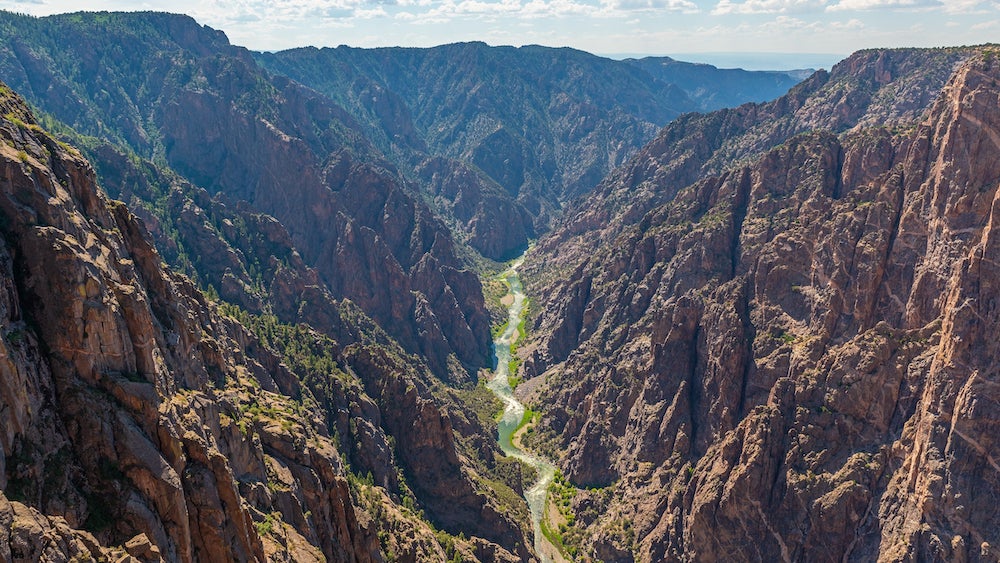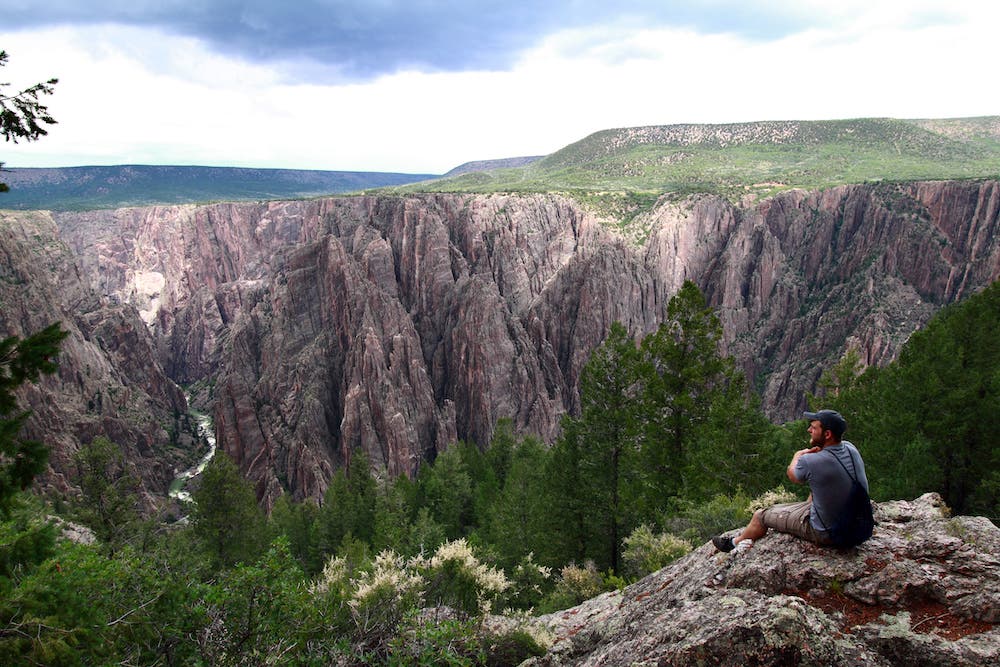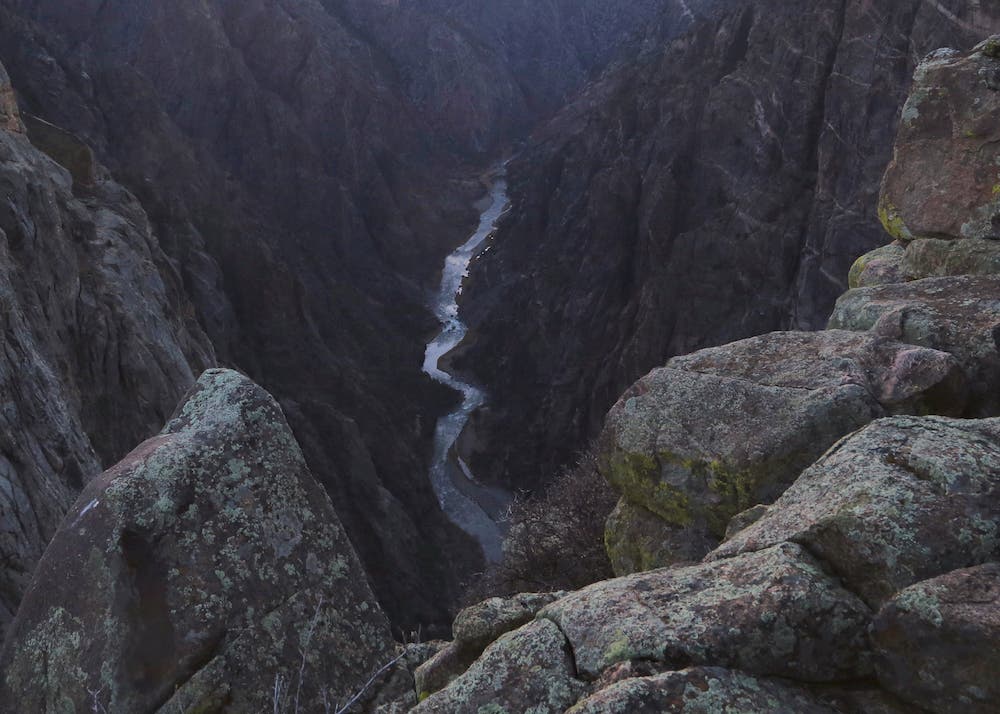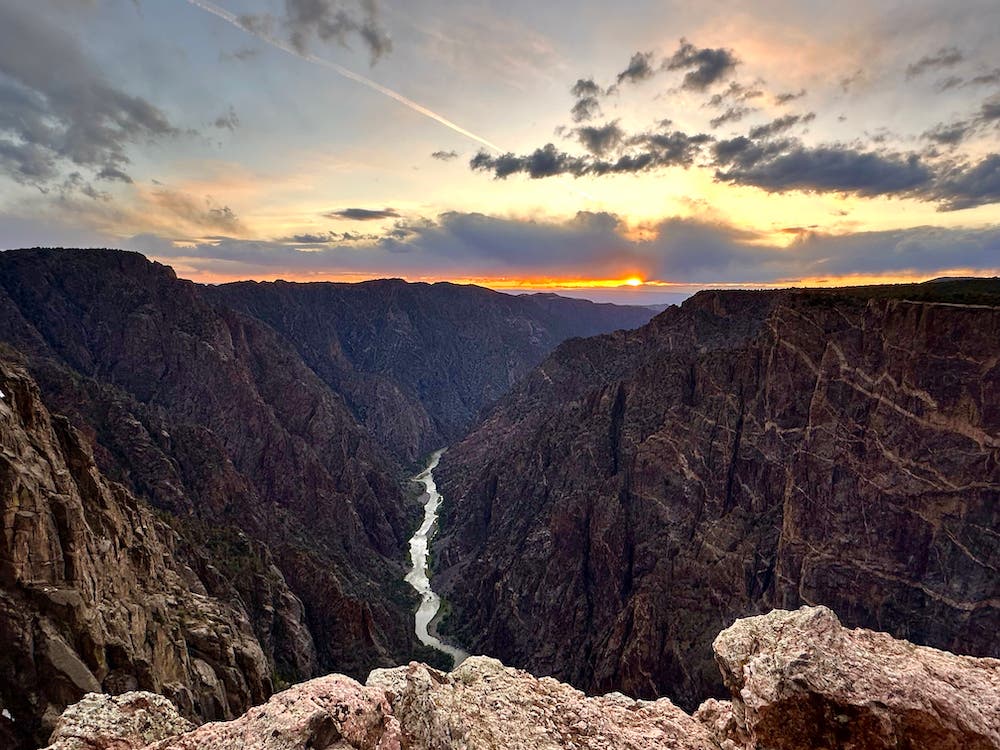Explore Colorado's Undiscovered Black Canyon

(Photo: SL_Photography via Getty Images)
As we scrambled across a gully of broken schist, surfing the sliding rocks, Fritz paused and said, “Do you hear it?”
I cocked an ear. “Hear what?”
Fritz grinned. “The thunder of the big river,” he said.
In the middle of America, where the Rocky Mountains slide into the desert Southwest and ponderosa pines give way to sagebrush, lies a canyon so dizzyingly steep that bighorn sheep, renowned for their cliff-climbing ability, sometimes fall from the sheer rock walls and die. The cut in the earth runs half a mile deep for nearly 15 miles. At the bottom of this knife-gash flows the river that made it–a waterway that, in the days before dams, would firehose through the canyon every spring, dropping at an average rate 10 times steeper than the Colorado River through the Grand Canyon. The Ute Indians called the place Tomichi, land of high cliffs and water. Early white settlers, mindful of the gorge’s dark, shadowy recesses, called it Black Canyon.
They named the river Gunnison after a 19th-century explorer who passed nearby without ever penetrating the inner Black Canyon. Nowadays the Gunny, as local fishermen call it, is chockablock with dams that keep its flow as steady and regular as lawn sprinklers set on a timer. Every once in a great while, though, the water that flows down from the Rockies overwhelms the best-laid concrete of mankind, and the mighty Gunny roars again. That’s what Fritz and I went looking for.
The Black Canyon of the Gunnison is one of America’s least known and most inscrutable national parks. Rocky, high-angle landscape both repels casual visitors and conceals the canyon’s secrets. The park, tucked into sage-and-piñon foothills in central Colorado, encompasses the most dramatic 14-mile stretch of a 53-mile gorge carved by the Gunnison River, which delivers snowmelt from the Rockies to the Colorado River.
Most who pay the gate fee come for the South Rim view, which is breathtaking, but not in the way the Grand Canyon wows with mass-market spectacle–CinemaScope wide, flaring off in postcard colors. In comparison, Black Canyon is a study in subtlety, a dark, deeply textured work of art. At its pinch point, the canyon V’s into a notch slimmer than the width of a basketball court. The Black lies almost entirely hidden until you step to the edge, peer over the side, and then–holy crap!–get a taste of what a half-mile drop, straight vertical, really means. Grip that guardrail, grandpa.
For most visitors, the experience ends there: Snap the photo, hit the gift shop, and into the car, everybody! That’s fine. Because it leaves the real treasure–going below the rim–to the rest of us.

The inner canyon has a reputation for offering its visitors a kind of exquisite punishment. Rock climbers test themselves on the 2,270-foot Painted Wall. World-class kayakers take on the river’s class 5 rapids–and a nasty mile-long portage. Fly-fishermen scramble down loose talus slopes peppered with poison ivy for a chance to wrestle with the Gunnison’s legendary brown and rainbow trout.
I was drawn to the Black Canyon by its mystery, its hard reputation, its legal battles, and its fleeting moments of glory. As a wilderness lover, I was tempted by the Black’s inaccessibility. The inner canyon offers some of the toughest hiking of any national park. The few routes down are short and steep, and so sketchy that the Park Service, by policy, refuses to call them trails. One path contains a pitch so precipitous that hikers pull themselves up with a heavy iron chain–the old-school version of a fixed rope.
As a journalist who’s covered water wars in the West, I was also drawn by the dramatic battle being fought over the water that runs through the Black and sustains its ecosystem. For decades, farmers and fishermen (and other environmentalists) have argued for their crops and their catches–each side demanding control over the Gunny’s flow. Even as we entered the canyon, the power players were back at the table, ordered there by a judge after conservationists brought a successful lawsuit. I was happy to skip that bureaucratic wrangling and report instead from the banks of the river itself–the thing that’s really at stake. All the same, I wanted to understand the underlying tension, so I boned up on Black Canyon history before the trip and invited Fritz Holleman, a leading Colorado water lawyer who also happens to be a good friend, able climber, and fly-fishing fanatic.
We hoped to enter via Red Rock Canyon, a route on the western edge of the park that remains unmarked on most maps. Reaching the trailhead involves crossing private ranchland, and the Park Service has an agreement with the owner to allow limited access from mid-May to early October. The Red Rock route is like a hip underground club: Few know it exists, but it’s so hot and exclusive that there’s always a crowd outside the velvet rope. The park holds a lottery for permits. (One hundred hikers are allowed per month; no reservations are required for the other inner canyon routes.)
We tossed our names into the hat and waited. In March 2008, we got the call. “They pulled our number!” I told Fritz. The dates were in late spring, Memorial Day weekend. On one of the year’s busiest holidays, and near the height of spring runoff, we’d have miles of the Black Canyon to ourselves.
“I’ll keep an eye on the water level,” I told Fritz.

In early May, the river started to rise. A big snow year meant that Colorado rivers were running high, and few ran higher than the Gunnison. While state officials, conservationists, farmers, and fishermen argued over how to divvy up the Gunny’s flow, it surged of its own accord, rising to levels not seen since 1995. And it kept rising. A few days before we set out, I spoke with Heather Boothe, a Black Canyon backcountry ranger. “We usually recommend people don’t cross the river at more than 500 cfs [cubic feet per second],” she told me. “Right now it’s running at 6,000.”
By the time we reached the trailhead, the river had broken 7,000 cfs and showed no signs of subsiding. Fritz and I had a shot at witnessing history. This was a once-a-decade rager, the kind of scouring flood that created the canyon, nurtured its wildlife, and made enemies out of farmers and fishermen.
Our route–less than 4 miles from trailhead to river–began on a ranch road. As Fritz and I strolled down the dirt two-track, adjusting our packs and dodging prairie-dog holes, the story of water in the West appeared in the landscape around us. North of the road–public land–was the time before irrigation: a shrubby desert marked by sagebrush and juniper trees. To the south–private land–was life after piped water: a lush green valley, cattle browsing an ocean of long grass. There’s an old saying in the arid West: Whiskey’s for drinking and water’s for fighting. “This is why,” Fritz said.
At the park boundary, we checked the backcountry logbook. Only two parties had passed this way over the previous five months. “River rose 1 foot in a day,” wrote one of our predecessors.
Green pasture gave way to an ever-narrowing gorge. Red Rock Canyon is one of the Black’s few side entries, since its creek maintains enough cutting force to keep up with the Gunnison’s relentless deepening of the main canyon. Fritz and I picked our way down the obscure, little-used trail marked with cairns. Low-hanging scrub oak limbs forced us to frog-step every 30 yards. Loose scree gave each of us a good ass-tumbling, and poison ivy nipped at our legs like yapping dogs. The Red was toughening us up for the Black.

Despite the modest distance and elevation change (the route drops 1,330 feet over 3.4 miles), Red Rock Canyon is slow going. But by late afternoon, the low foothills at the canyon’s head had given way to towering thousand-foot walls. Fritz and I turned a corner and entered the main cut of the Black. We paused to take it in. The sinking sun threw the canyon into sharp relief. Upriver, the cliffs seemed to fade and shift as the light caught, and then fled, different fins of rock. It was like looking upon a lost Albert Bierstadt painting.
The Gunny ran mighty indeed. It boiled and frothed and roared like a liquid freight train. Its milky green water swallowed bankside trees. It crashed into cliffs and spun into whirlpools. This was the Gunnison River in full flood, a sight not seen for more than a decade. I looked upstream and saw the river spread wall to wall. Downstream, it cliffed out after 50 yards. The opposite bank looked hikeable, but reaching it required a swim that would deep-six Michael Phelps. We had to shout to be heard over the 80-decibel roar.
We made camp in a meadow clearing, and dashed to the river to try our luck with the fish. Fritz tied on a Vegas showgirl of a fly–”Gotta give ’em something to see!” he shouted–and cast into the churning river. Overhead, white-throated swifts performed acrobatic sorties, nabbing bugs in midair. Our rods bounced with what might have been trout strikes, but it was tough to know for sure. The river ran so high and fast that the water itself pulled like a lunker.
As dusk fell, we made our way empty-handed back to camp. Fritz put on coffee, and we talked about Western water wars over the sound of the rapids. “We’re sitting here listening to the roar of the river,” Fritz told me as darkness enfolded the canyon, “but that phrase–roar of the river–is actually a growing legal concept. River towns in Colorado build kayak courses to attract adventure tourists, and the sound and feel of the river running high is part of the attraction. In the Grand Canyon, they’ve battled over sightseeing flights, which detract from the sound quality of the inner canyon and the experience of people floating the Colorado River.”
The battle over the Black began in 1933, when President Herbert Hoover, on his last full day in office, established the Black Canyon of the Gunnison National Monument. Nobody thought much about the river until 1956, when Congress authorized the construction of three dams upstream of the canyon. “When they proposed the dams, Congress said they’d always keep a little water flowing through the canyon to keep the fish alive,” Fritz told me. “They figured 100 cfs would do the trick.” That’s a stream you’d feel comfortable letting a 6-year-old splash in.
But 100 cfs didn’t do the trick. Three species of trout–brown, rainbow, and cutthroat, the Gunnison’s only native species–flourished in the river, and you needed 300 cfs to keep the fish healthy. And the trout didn’t just need more water; they needed a dynamic river. The Gunnison’s spring floods transported sediment, renewed the cycle of vegetation, and served as a spawning cue for fish. That pattern stopped around 1965, when the first of the three dams was completed. In 1971, the federal government sued to establish a water right for what was then the Black Canyon National Monument. Thus began a 37-year fight to get more water flowing through the canyon.

“Are you kidding me?” I said to Fritz. “Thirty-seven years?”
“Water rights adjudications can drag on,” Fritz said. “The need to solve them doesn’t become apparent until someone makes a strong bid for the water.”
That bid came from the booming suburbs around Denver, which needed water for new lawns and toilets in the 1990s. The flow through the Black Canyon took on added significance in 1999, when Congress upgraded the monument to a national park. The whole thing came to a head in January 2001. President Clinton, looking to shore up his environmental legacy, made an effort to seasonally triple the Gunnison River’s protected base flow (to 300 cfs) and guarantee that the runoff would roar through the canyon every spring.
The incoming Bush Administration promptly reversed the order and cut a deal with Colorado officials to scale back the Gunnison’s allotment. Environmental groups sued. “The deal didn’t give the park a water right,” said Bart Miller, a lawyer with Western Resource Advocates, a regional environmental group. “It gave it a water wish.” In 2006, a federal judge agreed and declared the Bush agreement illegal. The warring factions spent the next two years trying to craft a compromise. We turned in and drifted off to sleep, the roar of the river echoing off the canyon walls and into our ears.
The thing about roaring rivers is that they often make for lousy fishing. Fritz and I spent the next morning proving as much. We tempted the Black’s legendary trout with every hand-tied fly concoction in our boxes–nymphs, waterbugs, mosquitoes, wooly buggers. We got nothing. Over lunch, we decided to do a little exploring. Downstream, the river cliffed out after 20 yards, and getting by it would require harnesses and rope. Upstream, though, the map showed promise.
“It looks like there’s a nice streamside bar there, if we can get past this quarter-mile stretch,” Fritz said. Quarter of a mile. Just 400 yards. Shouldn’t be too tough.
A deer path near the river’s edge led around a short bend, then disappeared into the water where the river ripped past a sheer 20-foot cliff. “I bet we can hump around that outcrop,” I told Fritz. We scrambled over the cliff’s backside–and encountered another, higher cliff. And another beyond that. What looked straightforward from afar revealed itself to be a puzzle made of rotten rock. The farther we pushed upriver, the higher the canyon forced us to climb.
We were scrambling in the footsteps of history. According to legend, the Utes believed that no man could enter the canyon and return alive. In 1874, Ferdinand Hayden’s government expedition stumbled upon the rim of the Black. This was the age of heroic exploration in the American West. Hayden had just mapped Yellowstone, and John Wesley Powell had floated the Grand Canyon. At the Black, though, Hayden balked. He lowered one of his men by rope into the dark gorge. Upon his return, the shaken volunteer pronounced the Utes’ belief wholly valid. Hayden, peering over the rim, declared the canyon impenetrable, and moved on.
The first successful explorers weren’t driven by curiosity. They came to steal the water. In 1900, a party floated the river in search of a likely spot to drill an irrigation tunnel. The river sank their boat and the men barely escaped with their lives. The next year, two hardy engineers, Abraham Lincoln Fellows and William Torrence, succeeded on foot, surviving a harrowing trek by crossing and recrossing the river dozens of times. They found a good spot for a tunnel and set the stage for a half-century water war.
Fritz and I kept climbing. Flakes of schist, weakened by the freeze-thaw cycle, peeled off in our hands. We followed what we thought was a deer path. Then I took a closer look at the poop and prints.
“Um, Fritz, I think this is bighorn sheep territory,” I said. I glanced at my altimeter. We were 400 feet above the river. Fritz disappeared around a ledge. “I think we can make it down the next gully,” he said.
I gave it a look. Peering over the edge, I gained new insight into the relationship between Fritz and myself: He was, I realized while assessing the sketchy downclimb, a much, much better climber than me. “You go ahead,” I told him. “This is where my trail ends.”
Fritz wandered back into camp two hours later, still skunked. “When I climbed down to that bar, it turned out it wasn’t all that great,” he said. “Flat and barren, nowhere for the fish to hide.”
I handed him a cup of coffee, then returned to a book I’d brought along. It was an obscure title called Deep Black, by a young adventurer named Robb Magley. In the 1990s, Magley became intrigued by the Black and set out to thru-hike it with a buddy. They went at low water and still risked their lives crossing the cold, powerful river. They lasted three days. “A trip through Black Canyon,” Magley concluded, “is no easier today than it was for Torrence and Fellows.” Amen, brother.
Fritz and I spent another day with the river. We drank from it, waded in it, cast in vain into it. We watched 25 million cubic feet of water rush by in an hour, heading west, where it would eventually be spread over Arizona golf courses and California croplands. “It’s amazing, isn’t it?” said Fritz. “With all that water, you’d think we could take a little of it without harming anything.”
He knew, of course, the precise nature of the harm caused by such thinking.
As it happened, the official thinking about the Gunnison was changing even as we watched the river. The decades-long water war ended a few days after Fritz and I hiked out. The federal government, the farmers, the conservationists, and the state of Colorado reached a settlement that ensures a year-round base flow of 300 cfs, plus annual peak flows during runoff season. The base keeps the fish alive, and the peak flows maintain the whole ecosystem–scouring the sediment deposits, clearing woody debris, and cutting the canyon ever deeper. And making a deafening noise. Because the Black Canyon isn’t the Black Canyon without the roar of the river.
Bruce Barcott did not get a mean case of poison ivy while reporting this story, but Fritz Holleman did.
Plan It: Black Canyon of the Gunnison National Park
Getting There: The park is 15 miles east of Montrose, Colorado. To reach the South Rim Visitor Center, head east on I-50, then north for 6 miles on CO 347.
Hiking: All routes leading into the inner canyon are short, steep, and hard. The Red Rock Canyon Route descends 3.4 miles and 1,330 feet to a trio of campsites on the river. If you can’t get a permit for Red Rock (see below), several shorter and steeper routes (1 to 3 miles) offer access to riverside campsites. Caution: Poison ivy thrives in the inner canyon; wear long pants.
Permits: Only Red Rock Canyon requires advance reservations. It’s open for hiking from mid-May to early October; apply for a permit January to mid-March (nps.gov/blca/planyourvisit/redrockinfo.htm for details). Free wilderness permits are required (first come, first serve) for all hikers using other inner canyon routes.
Map: Trails Illustrated Black Canyon of the Gunnison National Park is good for planning ($14.95; natgeomaps.com); few inner canyon trails are mapped, but they’re so short that navigation is straightforward.
Season: The spring flood (May to early June) is spectacular for river watching. Once the water settles down in June, stoneflies hatch and fly-fishermen converge on the inner canyon for a catch-and-release frenzy. Fall brings cooler temps and lower flow, making it the best time to explore the inner canyon.
Info: (970) 641-2337; nps.gov/blca